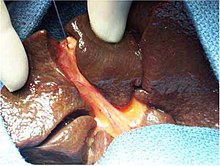Kasai operation
The Kasai operation (scientifically known as hepatoporto enterostomy ) is a method developed by the Japanese pediatric surgeon Morio Kasai in the late 1950s to treat biliary atresia , a rare congenital disease of the biliary tract that is fatal if left untreated. If left untreated, biliary atresia leads to cirrhosis and liver failure. In many cases, surgery prevents or delays this development, but a liver transplant is often required later .
principle
After opening the abdominal cavity, the diagnosis of biliary atresia is first confirmed by looking at the liver and biliary tract . The liver is then folded out of the abdominal cavity after cutting the ligaments by which it is attached to the abdominal wall. Now the part of the biliary tract outside the liver including the connective tissue between the right and left portal branch is removed. Finally, an approximately 40-45 cm long jejunal loop is cut out of the rest of the small intestine in a Y-shape ( Y-Roux loop ) and sewn side-to-end onto the exposed hepatic portal, so that the bile from the bile ducts running inside the liver can flow directly into the intestines can drain.
Complications
Due to the direct connection of the intestine with the biliary tract - favored by a slowed flow of bile - bacteria can rise into the biliary tract and lead to an acute inflammation, a cholangitis . This typically occurs in the first few weeks to months after the operation in one to two thirds of the operated children. Even if the flow of bile starts up again after the operation, the blood pressure in the portal vein can later increase ( portal hypertension ). The resulting varicose veins of the esophagus ( esophageal varices ) can usually be obliterated in a gastroscopy and then do not require any further therapy.
Source
- ↑ a b C. Chardot: Biliary atresia. Review. In: Orphanet Journal of Rare Diseases. 1, 2006, p. 28, PMC 1560371 (free full text)
